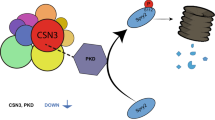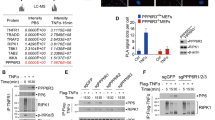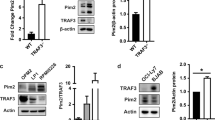Abstract
Type-2A protein phosphatase (PP2A) is a key regulator in many different cell signaling pathways and an important determinant in tumorigenesis. One of the signaling targets of PP2A is the mitogen-activated protein kinase (MAPK/ERK) cascade. In this study, we wanted to determine whether PP2A could be involved in regulation of death receptor activity through its capacity to regulate MAPK/ERK. To this end, we studied the effects of two different routes of protein phosphatase inhibition on death receptor-mediated apoptosis. We demonstrated that the apoptosis mediated by Fas, TNF-α, and TRAIL in U937 cells is suppressed by calyculin A, an inhibitor of type-1 and type-2A protein phosphatases. The inhibition of the protein phosphatase activity was shown to subsequently increase the MAPK activity in these cells, and the level of activation corresponded to the degree of suppression of cytokine-mediated apoptosis. A more physiological inhibitor, the intracellular PP2A inhibitor protein I2PP2A, protected transfected HeLa cells in a similar way from Fas-mediated apoptosis and induced activation of MAPK in I2PP2A transfected cells. A corresponding inhibition could also be obtained by stable transfection with a constitutively active form of the MAPK kinase, MKK1 (also referred to as MEK1). The inhibitor-mediated protection was highly efficient in preventing early stages of apoptosis, as no caspase-8 cleavage occurred in these cells. The observed apoptosis suppression is likely to facilitate the tumor-promoting effect of a range of different type-2A protein phosphatase inhibitors, and could explain the reported tumor association of I2PP2A.
This is a preview of subscription content, access via your institution
Access options
Subscribe to this journal
Receive 50 print issues and online access
$259.00 per year
only $5.18 per issue
Buy this article
- Purchase on Springer Link
- Instant access to full article PDF
Prices may be subject to local taxes which are calculated during checkout






Similar content being viewed by others
References
Al-Murrani SW, Woodgett JR and Damuni Z . (1999). Biochem. J., 341, 293–298.
Amaral MC, Casillas AM and Nel AE . (1993). Immunology, 79, 24–31.
Bialojan C and Takai A . (1988). Biochem. J., 256, 283–290.
Braconi Quintaje SB, Church DJ, Rebsamen M, Valloton MB, Hemmings BA and Lang U . (1996). Biochem. Biophys. Res. Commun., 221, 539–547.
Brautigan DL . (1997). Adv. Second Messenger Phosphoprotein Res., 31, 113–124.
Brautigan DL and Pinault FM . (1993). Mol. Cell. Biochem., 127–128, 121–129.
Carlson SG, Eng E, Kim EG, Perlman EJ, Copeland TD and Ballermann BJ . (1998). J. Am. Soc. Nephrol., 9, 1873–1880.
Chiang CW, Harris G, Ellig C, Masters SC, Subramanian R, Shenolikar S, Wadzinski BE and Yang E . (2001). Blood, 97, 1289–1297.
Chung H and Brautigan DL . (1999). Cell Signal., 11, 575–580.
Cohen P and Cohen PTW . (1989). J. Biol. Chem., 264, 21435–21438.
Cohen P, Holmes CFB and Tsukitani Y . (1990). TIBS, 15, 98–102.
Eriksson JE, Grönberg L, Nygård S, Slotte JP and Meriluoto JAO . (1990). Biochem. Biophys. Acta, 1025, 60–66.
Fernandez JJ, Candenas ML, Souto ML, Trujillo MM and Norte M . (2002). Curr. Med. Chem., 9, 229–262.
Fisher DE . (1994). Cell, 78, 539–542.
Fladmark KE, Brustugun OT, Hovland R, Boe R, Gjertsen BT, Zhivotovsky B and Doskeland SO . (1999). Cell Death Differ., 6, 1099–1108.
Fujiki H and Suganuma M . (1993). Adv. Cancer Res., 61, 143–194.
Gjertsen BT and Doskeland SO . (1995). Biochim. Biophys. Acta, 1269, 187–199.
Hahn WC, Dessain SK, Brooks MW, King JE, Elenbas B, Sabatini DM, DeCaprio JA and Weinberg RA . (2002). Mol. Cell. Biol., 22, 2111–2123.
Hahn WC and Weinberg RA . (2002). Nat. Rev. Cancer, 2, 331–341.
Holmström T, Chow SC, Elo I, Coffey ET, Orrenius S, Sistonen L and Eriksson JE . (1998). J. Immunol., 160, 2626–2636.
Holmström T and Eriksson JE . (2000). Crit. Rev. Immunol., 20, 121–152.
Holmström T, Tran SEF, Johnson VL, Ahn NG, Chow SC and Eriksson JE . (1999). Mol. Cell. Biol., 19, 5991–6002.
Holmström TH, Schmitz I, Söderström TS, Poukkula M, Johnson VL, Chow SC, Krammer PH and Eriksson JE . (2000). EMBO J., 19, 5418–5428.
Ishihara H, Martin BL, Brautigan DL, Karaki H, Ozaki H, Kato Y, Fusetani N, Watabe S, Hashimoto K, Uemura D and Hartshorne DJ . (1989). Biochem. Biophys. Res. Commun., 159, 871–877.
Lengyel E, WangH, Gum R, Simon C, Wang Y and Boyd D . (1997). Oncogene, 29, 2563–2573.
Lewis TS, Shapiro PS and Ahn NG . (1998). Adv. Cancer Res., 74, 49–149.
Ohoka Y, Nakai Y, Mukai M and Iwata M . (1993). Biochem. Biophys. Res. Commun., 197, 916–921.
Pallas DC, Shahrik LK, Martin BL, Jaspers S, Miller TB, Brautigan DL and Roberts TM . (1990). Cell, 60, 167–176.
Rosenberger SF and Bowden GT . (1996). Oncogene, 12, 2301–2308.
Santoro MF, Annand RR, Robertson MM, Peng YW, Brady MJ, Mankovich JA, Hackett MC, Ghayur T, Walter G, Wong WW and Giegel DA . (1998). J. Biol. Chem., 273, 13119–13128.
Sato S, Fujita N and Tsuruo T . (2000). Proc. Natl. Acad. Sci. USA, 97, 10832–10837.
Schulze-Osthoff K, Ferrari D, Los M, Wesselborg S and Peter ME . (1998). Eur. J. Biochem., 254, 439–459.
Shenolikar S and Nairn AC . (1991). Adv. Second Messenger Phosphoprotein Res., 23, 1–121.
Söderström TS, Poukkula M, Holmström TH, Heiskanen KM and Eriksson JE . (2002). J. Immunol., 169, 2851–2860.
Song Q and Lavin MF . (1994). Biochem. Biophys. Res. Comm., 190, 47–52.
Sontag E, Fedorov S, Kamibayashi C, Robbins D, Cobb MH and Mumby M . (1993). Cell, 75, 887–897.
Sorenson CM, Barry MA and Eastman A . (1990). J. Natl. Cancer Inst., 8, 749–755.
Tran SE, Holmstrom TH, Ahonen M, Kahari VM and Eriksson JE . (2001). J. Biol. Chem., 276, 16484–16490.
Von Lindern M, vaan Baal S, Wiegant J, Raap A and Grosveld G . (1992). Mol. Cell. Biol., 12, 3346–3355.
Walter G and Mumby M . (1993). Biochem. Biophys. Acta, 1155, 207–226.
Wright SC, Zhong J and Larrick JW . (1994). FASEB J., 8, 654–660.
Acknowledgements
We thank Helena Saarento for excellent technical assistance. Financial support from the Academy of Finland, the Finnish Cancer Foundations, the Sigrid Jusélius Foundation, the Victoria Foundation, and Åbo Akademi University are gratefully acknowledged.
Author information
Authors and Affiliations
Corresponding author
Rights and permissions
About this article
Cite this article
Härmälä-Braskén, AS., Mikhailov, A., Söderström, T. et al. Type-2A protein phosphatase activity is required to maintain death receptor responsiveness. Oncogene 22, 7677–7686 (2003). https://doi.org/10.1038/sj.onc.1207077
Received:
Revised:
Accepted:
Published:
Issue Date:
DOI: https://doi.org/10.1038/sj.onc.1207077
Keywords
This article is cited by
-
Transient PP2A inhibition alleviates normal tissue stem cell susceptibility to cell death during radiotherapy
Cell Death & Disease (2018)
-
The impact of phosphatases on proliferative and survival signaling in cancer
Cellular and Molecular Life Sciences (2018)
-
Modulation of ROS/MAPK signaling pathways by okadaic acid leads to cell death via, mitochondrial mediated caspase-dependent mechanism
Apoptosis (2011)
-
SET-induced calcium signaling and MAPK/ERK pathway activation mediate dendritic cell-like differentiation of U937 cells
Leukemia (2005)



